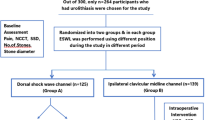Abstract
Object
We present the efficacy of shockwave lithotripsy (SWL) therapy administered with sedoanalgesia in infants with kidney stones.
Materials and methods
We enrolled 102 patients aged 5–24 months who had kidney stones and received SWL therapy under sedoanalgesia using a Siemens Lithostar Modularis device. Patient and stone characteristics, therapy parameters, pain score, complications, discharge time, and follow-ups were registered and evaluated. Pain score was assessed using a Neonatal Infant Pain Score (NIPS). Postanesthetic discharge scoring system (PADSS) was used for the assessments of postprocedural discharge procedure.
Results
Mean age of the patients was 17.2 ± 6.3 months (5–24 months). Mean stone size was 7.9 ± 3.3 mm (5–23 mm). The most common concomitant metabolic disorders were hypercalciuria and hypocitraturia. The stone-free rates of the infants were 70.6, 87.3, and 99.1 % after the first, second, and third sessions of SWL therapy, respectively. The mean NIPS scores procedure during, and at 1 h after SWL procedure were determined as 0.24 ± 0.45 and 0.34 ± 0.47, respectively. There was no statistically significant difference between two pain score values (P = 0.114). The mean discharge time of patients after the SWL procedure were 108.6 ± 27.9 min. Forty-two patients (41.1 %) were followed up. The follow-up period varied between 8 and 48 months (mean 19.5 months); none of those patients showed evidence of diabetes mellitus, hypertension, or renal function impairment.
Conclusions
SWL therapy under sedoanalgesia is a safe and efficient treatment modality that can be administered with low complication rates and high stone-free rates in the treatment of renal stones in infants.

Similar content being viewed by others
References
Tellaloglu S, Ander H (1984) Stones in children. Turk J Pediatr 26:51–60
Sharma AP, Filler G (2010) Epidemiology of pediatric urolithiasis. Indian J Urol 26(4):516–522
Sarica K (2006) Pediatric urolithiasis: etiology, specific pathogenesis and medical treatment. Urol Res 34(2):96–101
Ramakrishnan PA, Medhat M, Al-Bulushi YH et al (2007) Extracorporeal shockwave lithotripsy in infants. Can J Urol 14(5):3684–3691
Lottmann HB, Archambaud F, Traxer O et al (2000) The efficacy and parenchymal consequences of extracorporeal shock wave lithotripsy in infants. BJU Int 85(3):311–315
Shukla AR, Hoover DL, Homsy YL et al (2001) Urolithiasis in the low birth weight infant: the role and efficacy of extracorporeal shock wave lithotripsy. J Urol 165:2320–2323
Aldridge RD, Aldridge RC, Aldridge LM (2006) Anesthesia for pediatric lithotripsy. Paediatr Anaesth 16(3):236–241
Lawrence J, Alcock D, McGrath P et al (1993) The development of a tool to assess neonatal pain. Neonatal Netw 12(6):59–66
Chung F (1995) Recovery pattern and home-readiness after ambulatory surgery. Anesth Analg 80(5):896–902
Yoshida O, Okada Y (1990) Epidemiology of urolithiasis in Japan: a chronological and geographical study. Urol Int 45(2):104–111
Rizvi SA, Naqvi SA, Hussain Z et al (2002) Pediatric urolithiasis: developing nation perspectives. J Urol 168(4 Pt 1):1522–1525
Mishriki SF, Wills MI, Mukherjee A et al (1992) Extracorporeal shock wave lithotripsy for renal calculi in children. Br J Urol 69(3):303–305
Frick J, Köhle R, Kunit G (1988) Experience with extracorporeal shock wave lithotripsy in children. Eur Urol 14(3):181–183
Tan AH, Al-Omar M, Watterson JD et al (2004) Results of shockwave lithotripsy for pediatric urolithiasis. J Endourol 18(6):527–530
Schultz-Lampel D, Lampel A (2001) The surgical management of stones in children. BJU Int 87(8):732–740
Muslumanoglu AY, Tefekli A, Sarilar O et al (2003) Extracorporeal shock wave lithotripsy as first line treatment alternative for urinary tract stones in children: a large scale retrospective analysis. J Urol 170:2405–2408
Wadhwa P, Aron M, Seth A et al (2007) Pediatric shockwave lithotripsy: size matters! J Endourol 21(2):141–144
McLorie GA, Pugach J, Pode D et al (2003) Safety and efficacy of extracorporeal shock wave lithotripsy in infants. Can J Urol 10(6):2051–2055
Vandeursen H, Devos P, Baert L (1991) Electromagnetic extracorporeal shock wave lithotripsy in children. J Urol 145(6):1229–1231
Gofrit ON, Pode D, Meretyk S et al (2001) Is the pediatric ureter as efficient as the adult ureter in transporting fragments following extracorporeal shock wave lithotripsy for renal calculi larger than 10 mm.? J Urol 166(5):1862–1864
Aksoy Y, Ziypak T, Yapanoglu T (2009) Comparison of the effectiveness and safety of MPL 9000 and Lithostar Modularis shockwave lithotriptors: treatment results of 263 children. Urol Res 37(2):111–116
Bierkens AF, Hendrikx AJ, de Kort VJ et al (1992) Efficacy of second generation lithotriptors: a multicenter comparative study of 2,206 extracorporeal shock wave lithotripsy treatments with the Siemens Lithostar, Dornier HM4, Wolf Piezolith 2300, Direx Tripter X-1 and breakstone lithotriptors. J Urol 148:1052–1056
Ozbey I, Aksoy Y, Ziypak T et al (2007) Shock wave lithotripsy is effective and safe for distal ureteral calculi in children. Urol Res 35:237–241
Landau EH, Gofrit ON, Shapiro A et al (2001) Extracorporeal shock wave lithotripsy is highly effective for ureteral calculi in children. J Urol 165:2316–2319
Traxer O, Lottmann H, Archambaud F et al (1999) Extracorporeal lithotripsy in children. Study of its efficacy and evaluation of renal parenchymal damage by DMSA-Tc 99 m scintigraphy: a series of 39 children. Arch Pediatr 6(3):251–258
Claro Jde A, Denardi F, Ferreira U et al (1994) Effects of extracorporeal shockwave lithotripsy on renal growth and function: an animal model. J Endourol 8(3):191–194
Resorlu B, Unsal A, Tepeler A et al (2012) Comparison of retrograde intrarenal surgery and mini-percutaneous nephrolithotomy in children with moderate-size kidney stones: results of multi-institutional analysis. Urology 80(3):519–523
Smaldone MC, Cannon GM Jr, Wu HY et al (2007) Is ureteroscopy first line treatment for pediatric stone disease? J Urol 178(5):2128–2131
Unsal A, Resorlu B (2011) Retrograde intrarenal surgery in infants and preschool-age children. J Pediatr Surg 46(11):2195–2199
Conflict of interest
The authors declare that they have no conflict of interest.
Author information
Authors and Affiliations
Corresponding author
Rights and permissions
About this article
Cite this article
Adanur, S., Ziypak, T., Yılmaz, A.H. et al. Extracorporeal shockwave lithotripsy under sedoanalgesia for treatment of kidney stones in infants: a single-center experience with 102 cases. Int Urol Nephrol 46, 2095–2101 (2014). https://doi.org/10.1007/s11255-014-0788-9
Received:
Accepted:
Published:
Issue Date:
DOI: https://doi.org/10.1007/s11255-014-0788-9




